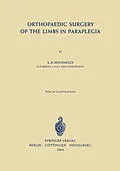In the rehabilitation of paraplegics reconstructive and corrective operations play a not unimportant part. Their chief value lies in assisting conservative measures as a means of speeding up the social reintegration of these severely disabled people. Furthermore, in certain groups of paraplegics, these operations establish the very basis for a successful rehabilitation. This applies in the first place to that group of spastic and flaccid paraplegics where inadequate early treat ment has led to severe tendon and joint contractures, secondly to that group of paraplegics who develop para-articular ossification of so far unexplained aetiology. The complex problems we meet in the rehabilitation of paraplegics demand exact indications for reconstructive and corrective operations. To fit them suitably into the overall-plan of treatment demands proper knowledge of the neurophysiology of spinal man. In almost twenty years a certain system of reconstructive and corrective operations has been developed at the National Spinal Injuries Centre, Stoke Mandeville. Dr. MICHAELIS, who has acquired considerable experience in the techniques of this operative and post-operative treatment, undertook the commen dable task of presenting these in a monograph. The special value of this publication lies in the description not only of the successes but also of the failures of operative treatment. I hope that this monograph will be a valuable help and guide for all doctors, whose responsible task and goal it is to achieve the social reintegration of the paraplegic.
Inhalt
Introduction: General surgical technique of operations on the limbs of paraplegics.- Anaesthesia.- a) Details.- b) Typical anaesthesia.- Neurological terminology.- The level of paraplegia.- Complete and incomplete paraplegia.- Spastic paraplegia.- Flaccid paraplegia.- Paralysis of autonomic mechanisms.- General statistics, Tables 1-7.- A. Operations for spasticity and contractures.- Prevention of contractures.- The right time for an operation.- The right type of operation.- Multiple operations.- The intrathecal alcohol block.- Operations for spasticity and contracture: General statistics, Tables 8-9.- Common-operations.- 1. Obturator neurectomy for spastic adduction-contracture at the hip (after Selig 1914) (Tables 10-12; Figg. 1,2).- a) Technique of the operation.- b) Postoperative treatment.- c) Complications and mistakes.- Summary.- 2. Iliopsoas myotomy for spastic flexion-contracture at the hip (Tables 13,14; Figg. 3-5).- a) Technique of the operation.- b) Postoperative treatment.- c) Complications and mistakes.- Summary.- 3. Tenomyotomy of the superficial flexors of the knee for spastic flexion-contracture (Tables 15-17; Figg. 6, 7).- a) Technique of the operation.- b) Postoperative treatment.- c) Complications and mistakes.- Summary.- 4. Elongation of the Achilles tendon for spastic pes equinus (Tables 18-20; Figg. 8,9).- a) Technique of the operation.- b) Postoperative treatment.- c) Complications and mistakes.- Summary.- Rare Operations.- 5. Open tenotomy of the tibialis posterior tendon.- 6. Tendon-transfer at the ankle.- a) Bilateral severely spastic pes equino-varus (Figg. 10,11).- b) Unilateral severely spastic pes equino-varus (Figg. 12-14).- c) Spastic pes equino-valgus.- 7. Neurotomy of the peroneal nerve.- 8. Subcutaneous tenotomies and corrections of spastic toes.- 9. Operations for flaccid limitation of extension at the hip.- 10. Cases.- Case I. Severe spastic flexion-contracture of the knee (Figg. 15, 16).- Case II. Severe flaccid flexion-contracture of both knee joints (Fig. 17).- Case III. Severe flaccid extension-contracture of the knee joints.- Case IV. Severe adduction and flexion-contracture of the hip with fixed subluxation (Fig. 18).- B. Arthroplasty for extension-ankylosis of the knee joint (Table 21; Figg. 19-21).- a) Indication.- b) Technique of the operation.- c) Postoperative treatment.- Summary.- C. Operations for para-articular ectopic ossification (Tables 22, 23; Figg. 22-24).- Pathology.- Methods of operation.- 1. Para-articular Pseudarthrosis.- a) Technique of the operation.- 2. Excision of the ectopic bone.- a) Technique of the operation.- b) Postoperative treatment.- Summary.- D. Operation for septic arthritis of the hip joint (Tables 24-26; Figg. 25-27).- Pathology.- a) Technique of the operation.- b) Postoperative treatment.- c) Complications and failures.- Summary.- E. Fractures of the long bones.- 1. Associated fractures of the long bones (Tables 27, 28; Figg. 28-35).- Priorities.- Conservative treatment.- Fracture-healing and spasticity.- Case V. Conservative treatment of threatened non-union of nailed femur.- Operative treatment.- a) Upper extremity: Early operations: Indications.- Case VI. Early open reduction and plating of the shaft of the humerus, in a case with radial palsy.- Case VII. Early open reduction and plating of the comminuted shaft of the humerus, combined with plexus-paralysis,..- Fractures of the forearm: Indications.- b) Upper extremity: Late operations: Indications.- Case VIII. Fracture of lower third of ulna combined with fracture-dislocation of T 8/9 vertebra, incomplete paraplegia and haemothorax, mediastinal tear and brain injury.- Case IX. Fracture of both bones of the forearm on one side and of the ulna on the other side, combined with fracture-dislocation of C. 5/6, complete quadriplegia below C. 6 and haemothorax.- c) Lower extremity: Late operations: Indications.- Case X. Supracondylar fracture of femur. Limitation of knee-flexion (Figg. 29,30).- Case XI. Comminuted fracture of tibial condyles. Limitation of knee-flexion (Fig. 31).- Case XII. Pseudarthrosis of femur. Plating and sliding graft (Figg. 32, 33).- Case XIII. Pseudarthrosis of the tibia. Sliding graft (Figg. 34, 35).- Summary.- 2. Late fractures: Indications.- Case XIV. Fracture of the proximal third of femur with severe spasticity 45 Case XV. Fracture of the neck of femur in a young man with a very incomplete cauda-equina lesion below L 4.- Small operative measures.- Summary.- F. Upper limb.- Tendon-transfers and arthrodesis of the wrist (Table 29; Figg. 36-38).- Indications.- Case XVI. Reconstruction of extensor carpi radialis (Fig. 36).- Tendon-transfers: Operative technique (Fig.37).- Case XVII. Arthrodesis of the wrist in a quadriplegic, complete below C. 4/5 (Fig. 38).- Summary.- G. Amputation.- Literature.
